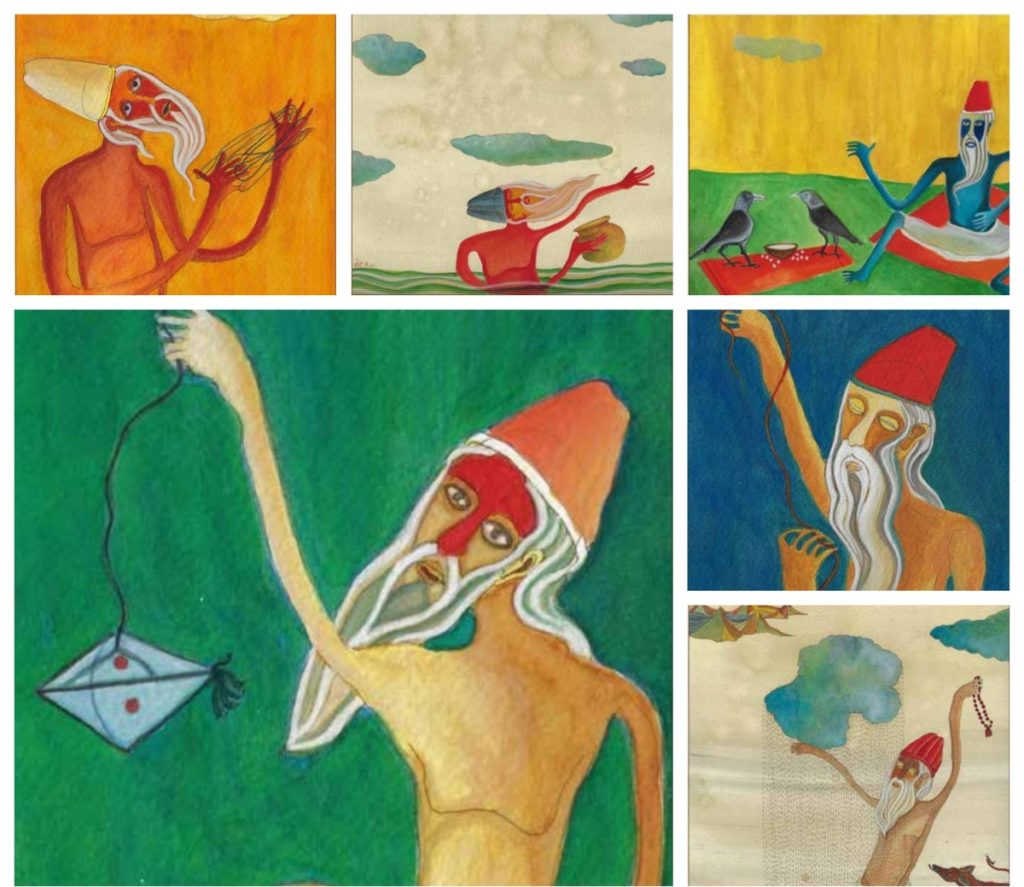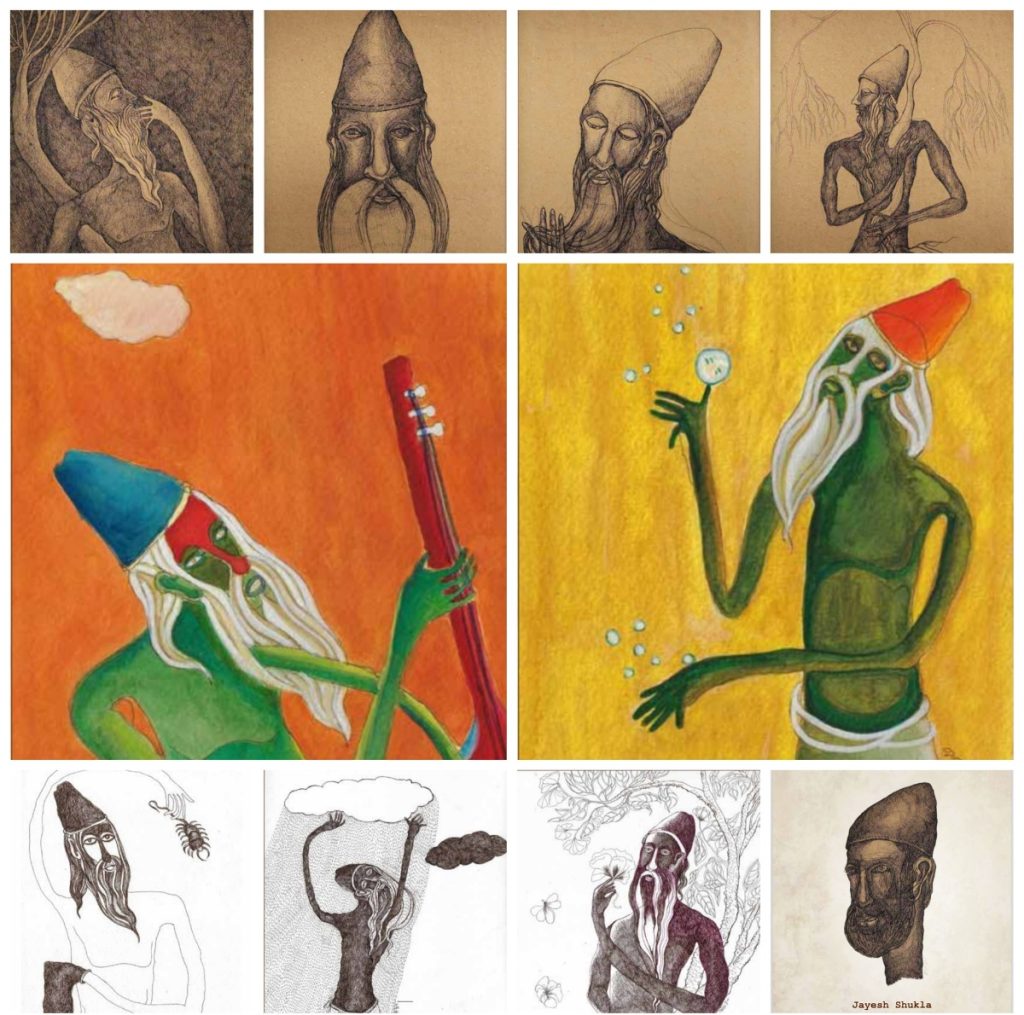Nippon Art Gallery Unveils Jayesh Shukla’s Solo Show
Nippon Art Gallery unveiled Jayesh Shukla’s solo show, ‘Main Khud’ featuring a series of more than sixty paintings inspired by the philosophy of Kabir. Sponsored by Gujrat State Lalitkala Academy, Ahmedabad, the exhibition will be held from 17th December to 21st December 2024.
Saint Kabir and His Teachings
A 15th-century mystic poet, Kabir has used abundant comparisons in his ‘Doha’ or couplets to deliver reflective spiritual actualities. He typifies the interconnectedness of life, the fleeting nature of being, and the pathway to divine cognizance. He parallels the soul to a raindrop merging with the ocean, embodying the union of the individual self with the divine; and lotus and mud to represent spiritual purity arising amidst worldly chaos.
Jayesh Shukla’s Artistry in ‘Main Khud’
Jayesh Shukla’s humble and unpretentious vocabularies in his drawings and paintings made with ink, pen and watercolours on paper, count on austereness and lucidity to convey sentimentalities, perceptions, or storylines without overwhelming details. Like Kabir’s modest couplets, the prominence is on the crux rather than amplification, creating an impressive visual experience. The composition reflects symbolic imagery entrenched with more profound connotations, letting the spectator find one’s meanings and understandings. The subtle minutiae of gestures or an object adds to the appeal, allowing connecting with the painting’s central quintessence.

The river’s expedition toward the sea reflects the soul’s pursuit for freedom; the fragility of life through metaphors like a flame extinguished by the wind. The epitome of these allegories is his mystical teachings in ordinary practices, making them accessible and everlasting. Through his forthright expression, Jayesh Shukla impassions Kabir’s reflective thoughtfulness of life’s essence and spiritual realisation. The artworks in ‘Main Khud’ may infer inner confusion, societal assessment, and the complexity of human identity. Each stroke, laden with subdued colours and reserved palette, or even fine lines, is measured, transmitting emotion, drive, mood and harmony. Neat, orderly and uncluttered arrangements focus on the subject, making the note appropriate and strong. His distorted human drawings encounter traditional acuities of form and proportion, arresting raw sensation or intangible conceptions. Overstated features, with bursting out or dreamy eyes, warped limbs, elongated arms, flying beards and titled heads, all invoke feelings of search, restlessness, curiosity, or intrigue.
A solitary human form in the composition, carrying a unique symbol makes one think of the original Doha and connect to the perception. In one place the artist has painted Kabir holding a rosary and immediately the following Doha comes to mind.
Mala to kar mein phire, jeebh phir mukh maahi, Manua to chahu dis phire, yeh to sumiran naahi
It reminds one to focus the mind on the divine, not randomly follow the outward act of turning beads. Simplicity is a stamp of Kabir’s doha. Jayesh Shukla exerts subsequent efforts to reflect his deep insight and belief in a direct and unadorned slant to mysticism and life. He supports humility, gratification, and detachment from a superfluous and covetous world, rejecting elaborate rituals and dogmas.
The Symbolism in Nippon Art Gallery’s Show
Kabir, a weaver by profession, uses the loom as a symbol of life, where each thread signifies actions and destiny woven by the divine. The bird imprisoned in a cage denotes the soul curbed by the material body and worldly attachments. Along with these narratives of rain, cloud, moon and ocean indicating the soul’s longing to merge with the divine, shedding individuality, Jayesh Shukla has also drawn a portrait encircled by nature and holding a flower which tells that everything unfolds at its own pace, one may water the plant endlessly, but the fruit is only borne in its season.
Dheere dheere re mana, dheere sab kuch hoye, maali seeche so ghara, rutt aye phal hoye.
Kabir’s Doha often employs intense and relatable imagery, comprising of roots, bubbles, and goats, to convey insightful metaphysical notions. Roots and branches which point to the foundation of life and spirituality can be seen in drawings by the artist. Though it is a straight depiction, yet enwraps Kabir’s deep concept of fostering strong, spiritual ‘roots’ by focusing on inner growth and detachment from worldly distractions. Playing with bubbles signifies the fleeting and fragile nature of life, underlining impermanence and the transient nature of worldly life. The kite (patang) has been painted as a symbol of human ambition, desires, and the consequences of being controlled by ego or attachments; soaring high but hitched to a thread to demonstrate the illusion of freedom, drifting high with pride or desires until it smashes when the cord breaks.
The scorpion has been chosen as an element in a drawing by Jayesh Shukla, showing it as a symbol of agony, unawareness, or negative leanings. It often represents the self-inflicted anguish caused by ego, attachment, or bad deeds. The sting of the scorpion serves as a reminder of the consequences of one’s actions and the need for self-awareness. Rain in his artworks denotes grace, blessings, and the divine’s nurturing existence. Crows in Jayesh Shukla’s art epitomize Kabir’s criticism of human tendencies to focus on external appearances, superficialities or trivialities, much like a crow scavenging for scraps, neglecting deeper truths.

Kaga sab tan khaiyo, mera chun chun khaiyo maas, Do naina mat khaiyo, mohe piya milan ki aas
The aforementioned quote echoes deep spiritual yearning to unite with the Almighty. Among many animals and insects suggesting human traits, spiritual lessons, and philosophical truths, Kabir has quoted the swan for purity and judgement; the ant representing modesty and hard work, reminding one of the values of trivial and unswerving efforts; and the bee symbolizes focus and the search for sweetness, akin to a seeker pursuing spiritual nectar. One can even musical instruments like bells and sitar and even toys like tops rotating over the hand and paper boats.
In a few words, one can say that symbolism is a governing factor in Kabir’s doha, as he uses vivid, everyday images as similes to carry thoughtful spiritual and philosophical ideas. These cyphers have been selectively picked by Jayesh and painted in poetic simplicity, which bridges the tangible and the abstract, making his ideologies relatable and relevant.
Image Courtesy – Dr Alka Chadha Harpalani

Alka is an artist and art writer with a diverse career spanning teaching, e-learning projects with the Ministry of Human Resource Development (MHRD), and editorial work. An alum of the Government College of Art, Chandigarh (BFA) and Banaras Hindu University, Varanasi (MFA, PhD), she has been recognised with numerous prestigious awards and honours.





